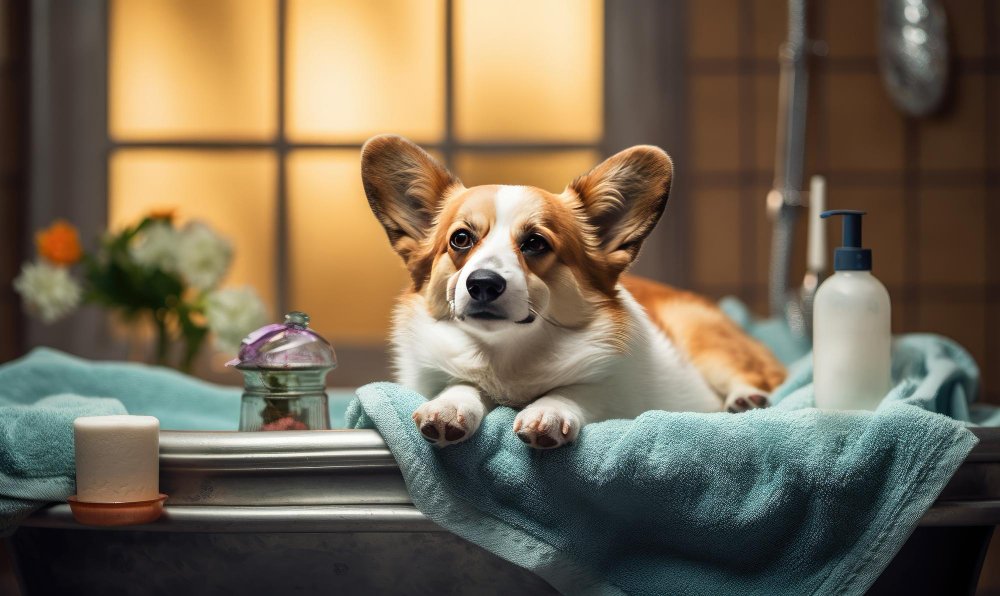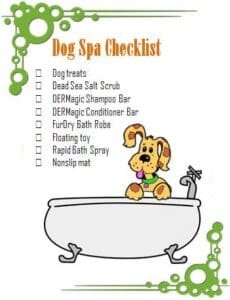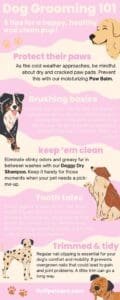Whether your furry friend needs some extra TLC or you simply want to treat them to a day of relaxation, creating a dog spa day at home is the perfect way to pamper your pooch. From luxurious bubble baths to soothing massages, this article will guide you through simple and affordable ways to transform your home into a haven of relaxation for your beloved pet. Your canine companion will thank you for the ultimate spa experience that will leave them feeling refreshed, rejuvenated, and oh so loved. Get ready to indulge your pooch in a day of pure bliss!
1. Preparing for a Dog Spa Day
1.1 Gathering supplies
Before starting your dog spa day, it’s important to gather all the necessary supplies. This includes towels, a gentle dog shampoo, a conditioner specifically formulated for dogs, a detangling spray, a brush suitable for your dog’s coat type, nail clippers, nail files, dog-friendly toothpaste and a toothbrush, and any other products you plan to use during the spa session. Having all your supplies ready will ensure a smooth and enjoyable experience for both you and your furry friend.
1.2 Setting the mood
Creating a relaxed and calming atmosphere is essential for a successful dog spa day. Find a quiet area in your home where you can set up your spa station. Use soft lighting, calming scents, and soothing music to create a serene ambiance. You can also use a diffuser with dog-friendly essential oils, such as lavender or chamomile, to help relax your pup.
1.3 Creating a safe environment
Before you begin pampering your pooch, it’s crucial to ensure that the environment is safe. Remove any potential hazards, such as sharp objects or toxic plants, from the area. Make sure the space is well-ventilated and at a comfortable temperature. It’s also wise to have a non-slip mat in place to prevent any accidents during bath time or nail trimming sessions. Taking these precautions will help keep your dog safe and secure throughout the spa day.
2. Relaxing Bath Time
2.1 Choosing the right products
When it comes to bath time, it’s important to choose the right products for your dog. Look for a gentle shampoo specifically formulated for dogs, as human shampoos can be too harsh and strip their natural oils. Consider your dog’s coat type and any specific skin conditions they may have when selecting a suitable shampoo. Similarly, opt for a conditioner that is designed for dogs to keep their coat soft and manageable.
2.2 Brushing and detangling
Before you begin the bathing process, it’s crucial to brush your dog’s coat to remove any tangles or mats. This not only helps in detangling but also distributes the natural oils in their fur, leaving it healthier and shinier. Use a brush suitable for your dog’s coat type and gently work through any knots. If your dog has a particularly stubborn tangle, you can use a detangling spray to make the process easier.
2.3 Proper bathing technique
When it’s time to bathe your dog, it’s important to follow the proper technique. Start by wetting their coat thoroughly, making sure to avoid getting water in their ears or eyes. Apply the shampoo and lather it gently, working it into their fur. Be careful not to scrub too vigorously, as this can cause skin irritation. Rinse your dog thoroughly, ensuring that all the shampoo is removed.
2.4 Massaging and relaxation
Bath time can be a great opportunity to give your dog a relaxing massage. While shampooing, use gentle circular motions to massage their muscles. This not only feels great for your pup, but it also helps improve circulation and promotes relaxation. Take your time and enjoy this bonding experience with your furry friend. After rinsing, wrap your dog in a soft towel and give them a gentle rubdown to dry off and further increase their relaxation.
3. Nourishing the Coat and Skin
3.1 Conditioning and moisturizing
After bath time, it’s essential to condition your dog’s coat to keep it healthy and moisturized. Use a dog-friendly conditioner, following the instructions on the bottle. Apply the conditioner evenly throughout your dog’s fur and leave it on for the recommended amount of time before rinsing thoroughly. Conditioning helps detangle the coat, reduce static, and keep the fur soft and shiny.
3.2 DIY natural remedies
If you prefer to use natural remedies for your dog’s coat and skin, there are several options you can try. Coconut oil is a popular choice as it helps moisturize the skin and adds shine to the coat. You can lightly massage a small amount of coconut oil onto your dog’s fur after bath time. Another natural remedy is oatmeal, which can be used as a soothing and moisturizing treatment for dry or irritated skin. Mix oatmeal with warm water to create a paste, apply it to the affected areas, and leave it on for a few minutes before rinsing off.
3.3 Paw and nose care
Don’t forget about your dog’s paws and nose during your spa day! Take some time to inspect your dog’s paws for any cuts, cracked pads, or foreign objects that may be lodged between their toes. Gently clean their paws with a damp cloth or pet-friendly wipes. You can also apply a paw balm or moisturizer to keep their pads soft and protected. Similarly, be sure to moisturize your dog’s nose, especially if it tends to get dry or cracked. There are specifically formulated nose balms available that can help keep their nose moisturized and prevent discomfort.
3.4 Treating dry or irritated skin
If your dog is prone to dry or irritated skin, there are steps you can take to provide relief. Adding a little bit of olive oil or fish oil to their food can help improve their skin and coat health from the inside out. Additionally, there are specially formulated supplements available that contain ingredients like omega-3 fatty acids, which promote healthy skin and reduce inflammation. It’s always best to consult with your veterinarian before starting any supplements to ensure they are suitable for your dog.
4. Fabulous Fur Styling
4.1 Trimming and shaping
If your dog’s fur is prone to matting or becomes unruly, regular trimming and shaping can help keep it looking fabulous. Invest in a good pair of grooming scissors or clippers, designed specifically for dogs, and learn how to trim their fur safely. Start with small, gradual trims, focusing on areas where mats tend to form, such as behind the ears or in long-haired breeds’ leg feathering. Always take your time and be cautious when trimming to avoid any accidents.
4.2 Coat type-specific grooming
Different coat types require specific grooming techniques. For example, dogs with long, flowing coats may need regular brushing to prevent tangles and maintain their coat’s appearance. Breeds with wiry or curly hair may benefit from professional hand-stripping or regular professional grooming sessions. Short-haired dogs may not require as much brushing but can benefit from a soft bristle brush to remove loose hair and stimulate the skin.
4.3 Fun and creative styling
During your dog spa day, why not have fun and get creative with your furry friend’s styling? You can experiment with different hairstyles, such as top knots or cute bows, for long-haired breeds. There are also temporary dog-safe hair dyes available if you want to add a splash of color to your dog’s fur. Just make sure to choose products specifically designed for dogs and follow the instructions carefully to ensure your pet’s safety.
4.4 Nail trimming and polishing
Trimming your dog’s nails is an essential part of their grooming routine. Long nails can be uncomfortable for your dog and lead to issues with their gait or foot health. Use a pair of dog nail clippers and trim the nails carefully, taking caution to avoid cutting the quick. If your dog has light-colored nails, you can usually see the pink quick, while it may be more challenging to identify in dogs with dark-colored nails. If you’re unsure, consult a professional groomer or veterinarian. After trimming, you can even add a little flair by using pet-safe nail polish or nail stickers to decorate your furry friend’s nails.
5. Relaxation Techniques
5.1 Calming aromatherapy
Aromatherapy can be an excellent tool for promoting relaxation during your dog spa day. Certain essential oils, such as lavender or chamomile, have calming properties that can help reduce stress and anxiety in dogs. However, it’s essential to note that not all essential oils are safe for dogs, as some can be toxic. Always do thorough research and consult with a veterinarian or a professional aromatherapist before using any essential oils on or around your dog.
5.2 Soothing music or white noise
Just like humans, dogs can benefit from soothing music or white noise to help them relax. Playing gentle classical music or ambient sounds, such as rainfall or ocean waves, can create a serene atmosphere and drown out any external noises that may cause stress for your furry friend. There are even apps and playlists specifically designed for calming dogs during spa or relaxation sessions.
5.3 Gentle massage techniques
Massaging your dog during spa time not only helps them relax but also provides various health benefits. Use gentle, circular motions to massage your dog’s muscles, starting from their neck and working your way down to their tail. This can help improve circulation, relieve tension, and promote overall well-being. Pay attention to your dog’s reactions and adjust your pressure accordingly. Some dogs may enjoy firmer massage strokes, while others may prefer a lighter touch.
5.4 Creating a cozy spa atmosphere
To enhance the relaxation experience, create a cozy nook for your dog to unwind. Use soft blankets or beds for them to lie on, ensuring they feel comfortable and secure. You can also dim the lights or use a soft, warm lamp to create a calming ambiance. Adding a cozy blanket or towel scented with lavender or chamomile can provide an extra level of comfort. Remember, the goal is to make your dog feel safe and relaxed, so tailor the atmosphere to their preferences.
6. Dental Care
6.1 Brushing and oral hygiene
Maintaining your dog’s dental health is crucial for their overall well-being. Regular brushing helps prevent tartar buildup, gum disease, and bad breath. Use a dog-friendly toothbrush and toothpaste specially formulated for dogs. Brushing your dog’s teeth may take some practice, so start gradually and be patient with your furry friend. Aim to brush their teeth at least three times a week, if not daily, for optimal oral hygiene.
6.2 Dog-friendly dental products
In addition to brushing, there are other dental care products available to support your dog’s oral health. Dental chews and treats designed to promote dental hygiene can help reduce plaque and tartar buildup. Look for products with the Veterinary Oral Health Council (VOHC) seal of approval to ensure their effectiveness. There are also water additives and dental sprays that can be added to your dog’s drinking water or sprayed directly onto their teeth to freshen their breath and combat bacteria.
6.3 Professional dental cleaning
If your dog’s teeth require a more thorough cleaning, your veterinarian can perform a professional dental cleaning. This typically involves a comprehensive examination, scaling to remove tartar, polishing, and potentially extractions, if necessary. Professional dental cleanings are done under anesthesia to ensure your dog’s safety and comfort. Regular check-ups with your veterinarian can help catch any dental issues early and prevent more severe problems down the line.
7. Treating Your Pooch to Special Treats
7.1 Homemade dog treats
Part of the spa day experience includes indulging your dog with special treats. Homemade dog treats can be a healthier alternative to store-bought options, as you have control over the ingredients used. There are countless recipes available online that cater to various dietary restrictions and preferences. Whether you choose to bake some delicious peanut butter and banana biscuits or freeze some fruit and yogurt popsicles, your furry friend is sure to appreciate the extra effort and taste.
7.2 Frozen treats for hot days
During hot summer months, frozen treats can provide some much-needed relief for your dog. You can make refreshing frozen treats by blending dog-friendly ingredients such as yogurt, fruits like watermelon or blueberries, and a splash of water. Pour the mixture into ice cube trays or silicone molds and freeze them until solid. These icy treats will not only cool down your pup but also provide a tasty and healthy snack.
7.3 Rewarding and bonding through treats
Treats can be a powerful tool in rewarding and bonding with your dog. During your spa day, use treats to reinforce positive behavior, such as staying calm during grooming or following commands. By praising and rewarding your dog with treats, you create positive associations with the spa experience, making future grooming or training sessions more enjoyable. Remember to use treats in moderation and choose options that are suitable for your dog’s dietary needs.
8. Safe and Fun Pawdicures
8.1 Paw soaking and cleansing
Before giving your dog a pawdicure, it’s important to soak their paws to soften the nails and remove any debris. You can create a gentle paw soak by filling a shallow basin with warm water and adding a pet-friendly cleanser or a few drops of mild soap. Allow your dog’s paws to soak for a few minutes, and then pat them dry with a soft towel.
8.2 Nail trimming and filing
Once the paws are clean and dry, it’s time to trim and file your dog’s nails. Use a pair of dog-specific nail clippers and carefully trim the tips of the nails, taking care not to cut into the quick. If your dog’s nails are dark-colored, it can be more challenging to see the quick. Trim small amounts at a time and gradually work your way to the desired length. After trimming, use a nail file or emery board to smooth any rough edges.
8.3 Nail polish and embellishments
If you want to add a touch of glam to your dog’s pawdicure, you can use pet-safe nail polish or even apply some cute nail stickers. Make sure to choose products specifically formulated for dogs, as human polishes or adhesives can be toxic to them. Allow the polish to dry completely before letting your dog walk or groom themselves to avoid smudging.
8.4 Choosing pet-safe products
When it comes to pawdicures, it’s essential to use pet-safe products and tools. Human nail products, such as polishes or adhesives, often contain harmful chemicals that can be toxic to dogs if ingested or absorbed through their paws. Stick to products that are specifically designed for dogs or consult with a professional groomer for recommendations.
9. Promoting Mental Stimulation
9.1 Engaging toys and puzzles
Mental stimulation is just as important as physical exercise for dogs. Engaging toys and puzzles can help keep your pup’s mind active and entertained. Look for interactive toys that require problem-solving skills, such as treat-dispensing puzzles or toys that challenge your dog’s sense of smell. Rotate the toys regularly to prevent boredom and keep your furry friend excited and engaged.
9.2 Interactive playtime
In addition to toys and puzzles, interactive playtime with you is essential for mental stimulation. Engage your dog in games like hide-and-seek or fetch, and reward them with treats or praise when they exhibit desired behavior. Playtime not only provides mental stimulation but also strengthens the bond between you and your pooch.
9.3 Mental exercises for dogs
There are various mental exercises you can do with your dog to keep their minds sharp. Teach them new tricks or commands and practice obedience training regularly. Incorporate problem-solving games, such as finding hidden treats or navigating an obstacle course, into their routine. Mental exercises challenge your dog’s cognitive abilities and help prevent boredom and behavioral issues.
9.4 The benefits of mental stimulation
Providing mental stimulation for your dog has numerous benefits. It helps prevent destructive behaviors that can result from boredom, such as excessive chewing or digging. Mental exercises also tire out your dog’s mind, which can be particularly useful for high-energy breeds. Additionally, mental stimulation promotes problem-solving skills and can enhance your dog’s ability to learn and retain information.
10. Reinforcing Positive Behavior
10.1 Rewards and praise
Reinforcing positive behavior is key to nurturing a well-behaved and happy dog. Use rewards and praise to encourage desirable actions and reinforce good habits. Whenever your dog exhibits the behavior you want, whether it’s staying calm during grooming or responding to a command, lavish them with praise, gentle pets, and a tasty treat. This positive reinforcement strengthens the bond between you and your dog and encourages them to repeat the desired actions.
10.2 Correcting unwanted behavior
While positive reinforcement is essential, it’s also crucial to correct unwanted behavior in a gentle and consistent manner. When your dog engages in undesirable actions, redirect their attention to an appropriate behavior and reward them for following through. Avoid using harsh punishments or physical force, as these may cause fear or aggression in your dog. Consistency, patience, and positive reinforcement are key in correcting unwanted behaviors effectively.
10.3 Creating a positive training environment
To reinforce positive behavior, it’s important to create a positive training environment. This includes using positive reinforcement methods, such as treats, toys, or praise, when teaching your dog new commands or tricks. Make sure the training sessions are short and enjoyable, and always end on a positive note. Having a calm and nurturing environment helps your dog feel safe and motivated to learn and engage with you.
10.4 Professional training options
If you’re facing challenges with training or behavior issues, seeking professional help can be beneficial. Professional dog trainers or behaviorists have the knowledge and experience to address specific issues and implement effective training techniques. They can provide guidance, develop personalized training plans, and help you understand and communicate with your dog better. Professional training options range from basic obedience classes to specialized behavior modification programs, catering to different needs and goals.
By following these comprehensive steps and investing time in pampering your pooch at home, you can create a dog spa day experience that promotes relaxation, bonding, and overall well-being for your furry friend. Remember, the goal is to provide a safe and enjoyable environment where your dog can feel loved, nurtured, and deeply cared for. So go ahead, grab your supplies, set the mood, and embark on a wonderful journey of pampering your precious pooch!



